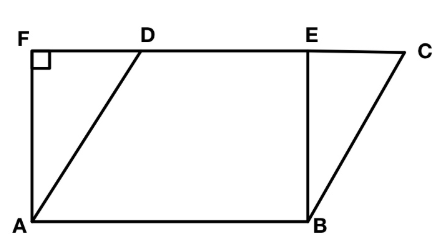
In the given figure, if parallelogram ABCD and rectangle ABEF are equal area then:

A. Perimeter of ABCD =Perimeter of ABEF
B. Perimeter of ABCD < Perimeter of ABEF
C. Perimeter of ABCD>Perimeter of ABEF
D. Perimeter of ABCD=$$\dfrac{1}{2} \times$$(Perimeter of ABEF)

Answer
599.1k+ views
Hint: In this question it is given that if a parallelogram ABCD and rectangle ABEF are equal in area then we have to find the relation between the perimeter of ABCD and the perimeter of ABEF.
So to find the relation between their perimeters we first need to find the relation between their corresponding sides.
Complete step-by-step answer:
As we know that the opposite sides of a rectangle and as well as parallelogram are equal.
So we can write, for rectangle ABEF
AB=EF………(1)
AF=BE……....(2)
And for a parallelogram ABCD,
AB=CD……….(3)
AD=BC…….....(4)
Since rectangle ABEF and parallelogram ABCD have the same base AB and have equal areas,
So from equation (1) and (3) we can write,
CD=EF…….(5)
In $\triangle ADF$, $$\angle AFD=90$$
Which implies,$\triangle ADF$ forming a right angle.
So for an right angle triangle hypotenuse > perpendicular
So we can write AD>AF……..(6)
Similarly, for $\triangle BCE$
BC>BE……….(7)
Now we add (6) and (7)
AD+BC>AF+BE
Or, AB+AD+BC>AB+AF+BE [adding AB in the both side]
Or, AB+AD+BC+CD>AB+AF+BE+EF [ since, EF=CD]
It can be written as,
AB+BC+CD+DA>AB+BE+EF+FA [since AD=DA and AF=FA].......(8)
Now as we know that,
Perimeter of a parallelogram ABCD=AB+BC+CD+DA
And perimeter of a rectangle ABEF=AB+BE+EF+FA
So from (8) we can write,
Perimeter of ABCD>Perimeter of ABEF
So the correct option is option C.
Note: To solve this type of question you need to have the basic idea about perimeter and how to measure the perimeter of a rectangle and parallelogram, i.e, the summation of all the sides. Also one more concept is that while adding two inequalities we have to add the left side of one inequation with the left side of the other inequation and similarly in right side also , like we did with the inequations (6) and (7).
So to find the relation between their perimeters we first need to find the relation between their corresponding sides.
Complete step-by-step answer:
As we know that the opposite sides of a rectangle and as well as parallelogram are equal.
So we can write, for rectangle ABEF
AB=EF………(1)
AF=BE……....(2)
And for a parallelogram ABCD,
AB=CD……….(3)
AD=BC…….....(4)
Since rectangle ABEF and parallelogram ABCD have the same base AB and have equal areas,
So from equation (1) and (3) we can write,
CD=EF…….(5)
In $\triangle ADF$, $$\angle AFD=90$$
Which implies,$\triangle ADF$ forming a right angle.
So for an right angle triangle hypotenuse > perpendicular
So we can write AD>AF……..(6)
Similarly, for $\triangle BCE$
BC>BE……….(7)
Now we add (6) and (7)
AD+BC>AF+BE
Or, AB+AD+BC>AB+AF+BE [adding AB in the both side]
Or, AB+AD+BC+CD>AB+AF+BE+EF [ since, EF=CD]
It can be written as,
AB+BC+CD+DA>AB+BE+EF+FA [since AD=DA and AF=FA].......(8)
Now as we know that,
Perimeter of a parallelogram ABCD=AB+BC+CD+DA
And perimeter of a rectangle ABEF=AB+BE+EF+FA
So from (8) we can write,
Perimeter of ABCD>Perimeter of ABEF
So the correct option is option C.
Note: To solve this type of question you need to have the basic idea about perimeter and how to measure the perimeter of a rectangle and parallelogram, i.e, the summation of all the sides. Also one more concept is that while adding two inequalities we have to add the left side of one inequation with the left side of the other inequation and similarly in right side also , like we did with the inequations (6) and (7).
Recently Updated Pages
Master Class 10 General Knowledge: Engaging Questions & Answers for Success

Master Class 10 Science: Engaging Questions & Answers for Success

Master Class 10 Social Science: Engaging Questions & Answers for Success

Master Class 10 Maths: Engaging Questions & Answers for Success

Master Class 10 English: Engaging Questions & Answers for Success

Master Class 10 Computer Science: Engaging Questions & Answers for Success

Trending doubts
Why is there a time difference of about 5 hours between class 10 social science CBSE

Write a letter to the principal requesting him to grant class 10 english CBSE

What is the median of the first 10 natural numbers class 10 maths CBSE

The Equation xxx + 2 is Satisfied when x is Equal to Class 10 Maths

Which of the following does not have a fundamental class 10 physics CBSE

State and prove converse of BPT Basic Proportionality class 10 maths CBSE




